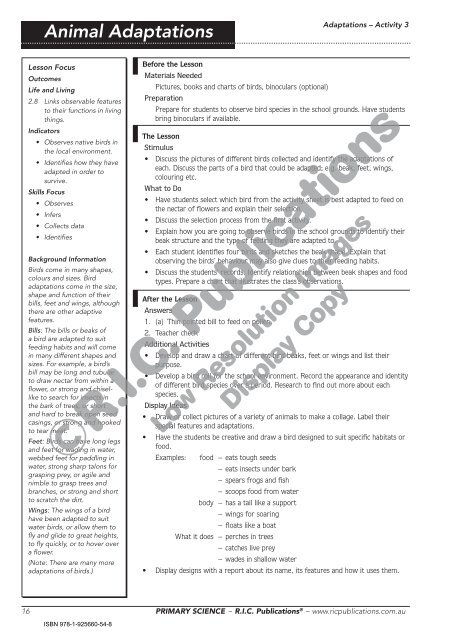RIC-3531 Primary Science - Book D (Digital)
Create successful ePaper yourself
Turn your PDF publications into a flip-book with our unique Google optimized e-Paper software.
Animal Adaptations<br />
Adaptations – Activity 3<br />
Lesson Focus<br />
Outcomes<br />
Life and Living<br />
2.8 Links observable features<br />
to their functions in living<br />
things.<br />
Indicators<br />
• Observes native birds in<br />
the local environment.<br />
• Identifies how they have<br />
adapted in order to<br />
survive.<br />
Skills Focus<br />
• Observes<br />
• Infers<br />
• Collects data<br />
• Identifies<br />
Background Information<br />
Birds come in many shapes,<br />
colours and sizes. Bird<br />
adaptations come in the size,<br />
shape and function of their<br />
bills, feet and wings, although<br />
there are other adaptive<br />
features.<br />
Bills: The bills or beaks of<br />
a bird are adapted to suit<br />
feeding habits and will come<br />
in many different shapes and<br />
sizes. For example, a bird’s<br />
bill may be long and tubular<br />
to draw nectar from within a<br />
flower, or strong and chisellike<br />
to search for insects in<br />
the bark of trees, or short<br />
and hard to break open seed<br />
casings, or strong and hooked<br />
to tear meat.<br />
Feet: Birds can have long legs<br />
and feet for wading in water,<br />
webbed feet for paddling in<br />
water, strong sharp talons for<br />
grasping prey, or agile and<br />
nimble to grasp trees and<br />
branches, or strong and short<br />
to scratch the dirt.<br />
Wings: The wings of a bird<br />
have been adapted to suit<br />
water birds, or allow them to<br />
fly and glide to great heights,<br />
to fly quickly, or to hover over<br />
a flower.<br />
(Note: There are many more<br />
adaptations of birds.)<br />
Before the Lesson<br />
Materials Needed<br />
Pictures, books and charts of birds, binoculars (optional)<br />
Preparation<br />
Prepare for students to observe bird species in the school grounds. Have students<br />
bring binoculars if available.<br />
The Lesson<br />
Stimulus<br />
• Discuss the pictures of different birds collected and identify the adaptations of<br />
each. Discuss the parts of a bird that could be adapted; e.g. beak, feet, wings,<br />
colouring etc.<br />
What to Do<br />
• Have students select which bird from the activity sheet is best adapted to feed on<br />
the nectar of flowers and explain their selection.<br />
• Discuss the selection process from the first activity.<br />
• Explain how you are going to observe birds in the school grounds to identify their<br />
beak structure and the type of feeding they are adapted to.<br />
• Each student identifies four birds and sketches the beak shape. Explain that<br />
observing the birds’ behaviour may also give clues to their feeding habits.<br />
• Discuss the students’ records. Identify relationships between beak shapes and food<br />
types. Prepare a chart that illustrates the class’s observations.<br />
After the Lesson<br />
Answers<br />
1. (a) Thin pointed bill to feed on pollen.<br />
2. Teacher check<br />
Additional Activities<br />
• Develop and draw a chart of different bird beaks, feet or wings and list their<br />
purpose.<br />
• Develop a bird roll for the school environment. Record the appearance and identity<br />
of different bird species over a period. Research to find out more about each<br />
species.<br />
Display Ideas<br />
• Draw or collect pictures of a variety of animals to make a collage. Label their<br />
special features and adaptations.<br />
• Have the students be creative and draw a bird designed to suit specific habitats or<br />
food.<br />
Examples: food – eats tough seeds<br />
– eats insects under bark<br />
– spears frogs and fish<br />
– scoops food from water<br />
body – has a tail like a support<br />
– wings for soaring<br />
– floats like a boat<br />
What it does – perches in trees<br />
– catches live prey<br />
– wades in shallow water<br />
• Display designs with a report about its name, its features and how it uses them.<br />
©R.I.C. Publications<br />
Low Resolution Images<br />
Display Copy<br />
16 PRIMARY SCIENCE ~ R.I.C. Publications ® ~ www.ricpublications.com.au<br />
ISBN 978-1-925660-54-8


















